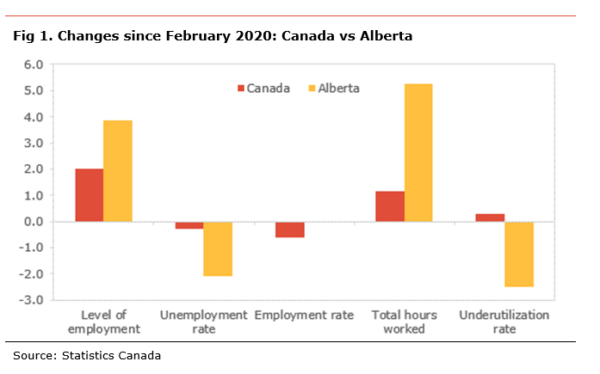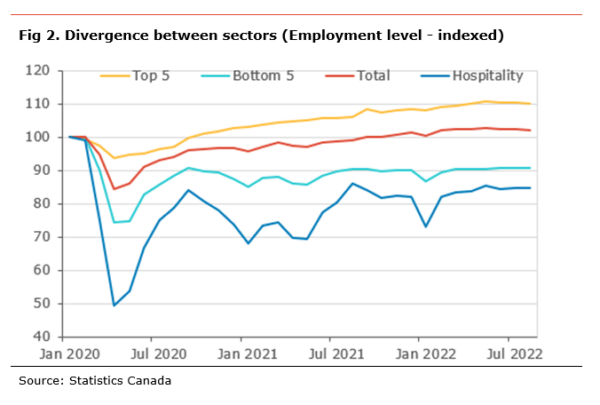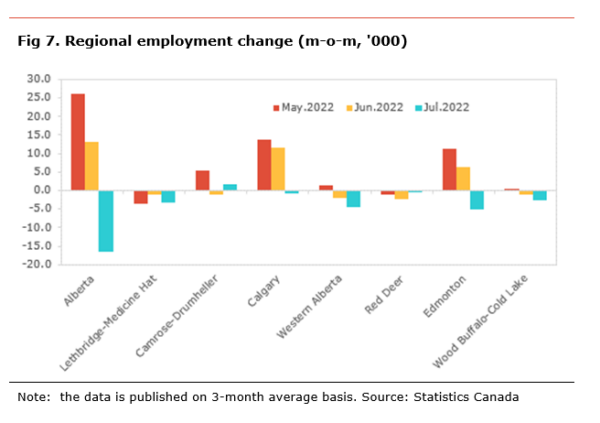Economic commentary provided by Alberta Central Chief Economist Charles St-Arnaud. This report includes regional details for Alberta.
Bottom line
Today’s Labour Force Survey data suggest the labour market in Canada is stalling. As such, employment declined for a third consecutive month, for a loss of a little more than 110k jobs. Moreover, the unemployment rate rose to 5.4%, after reaching record lows the previous two months. Those are signs of a gradual reduction in tightness in the labour market and will be welcomed by the Bank of Canada.
At its policy meeting on Wednesday and in a recent speech by Senior Deputy Governor Rogers, the BoC made it clear that it is considering increasing its policy rate further. Today’s report is unlikely to change this view. As we have explained on numerous occasions, the Bank of Canada needs to slow growth and create some excess capacity in the economy to fight inflation. A rising unemployment rate and job losses are signs that some slack is gradually being created in the economy and that the central bank is on a path to achieving its goal. With that in mind, further weakening of the labour market should be expected.
We believe the deterioration in the labour market will unlikely sway the Bank of Canada at this point, as the central bank remains focused on inflation. As such, the outlook for the policy rate remains dependent on incoming inflation numbers. Nevertheless, the weakening of labour market conditions suggests that the magnitude of the rate hike to come is likely to be smaller. We believe that a 25bp hike in October and December remains expected.
Alberta also saw a decline in employment in August, the first since the Fall of 2021, and the unemployment rate jumped to 5.4%. However, it is important to note that the low unemployment rate is partly the result of workers having left the labour market, as shown by the participation rate remaining below its pre-pandemic level. As such, if the participation rate was the same as before the pandemic, the unemployment rate in the province would be much higher at 7.4%.
Employment fell by 39.7k in August, the third consecutive decline in employment. Over the past three months, employment has decreased by 113.5k. With the drop in employment, the unemployment rate rose to 5.4%. The increase was also partly the result of a small increase in the participation rate to 64.8% from 64.7%. The participation is 0.8 percentage points (pp) lower than before the pandemic, as workers left the labour force. If the participation was the same as before the pandemic, the unemployment rate would be 6.1%. The employment rate, the share of the population holding a job, edged lower to 61.3% from 61.6%, below its pre-COVID level.
The details show that the job losses in August were in full-time (-77.2k), while part-time jobs rose (+37.5k). In addition, the decrease in employment was broad-based with declines in the public sector (-28k), self-employed (-8k) and private sector jobs (-4k).
On an industrial level, the decrease in employment was seen in both the service sector (-26k) and the goods-producing sector (-14k).
The details in the good-producing sector show that a decline in construction (-28k) and manufacturing (-7k) was partly offset by gains in agriculture (+9k), utilities (+6k), and natural resources (+6k).
The decline in the service industry was mainly in education (-50k), business, building and other support services (-11k), and transport and warehousing (-8k). These declines were partly offset by gains in other services (+15k), professional, technical and scientific (+14k), and finance, insurance and real estate (+8k).
Despite the overall level of employment being above its pre-COVID level, only 11 out of 16 industries have a level of employment above its pre-pandemic level. The lagging sectors are: agriculture, transport and warehousing, business, building and other support services, accommodation and food services, and other services. Employment in the accommodation and food services is still about 15% below its pre-COVID-19 level, the worst-performing industry.
In Alberta, employment declined by 6.5k in August, the first decline since October 2021. The unemployment rate jumped to 5.4% from 4.8%, as a result of the decline in employment. The participation rate in the province was unchanged at 68.8%, still 1.6 percentage points (pp) below its pre-pandemic level suggesting many workers are remaining on the sidelines. If the participation rate was at the same level as before the pandemic, the unemployment rate in the province would be 7.4%. The employment rate, the share of the population holding a job, inched lower to 65.1% from 65.5%, on par with its pre-pandemic level.
The job losses in Alberta were mainly in the service sector (-14k), while there were some gains in the goods-producing sector (+7k). The gains in the goods-producing industry were in agriculture (+8k), manufacturing (+5k), and natural resources (+4k). These gains were partly offset by a sizeable decline in the construction sector (-11k).
The job performance in the service sector was mixed. There were job losses in accommodation and food services (-7k), education (-6k), health care (-5k), and trade (-5k). Those losses were partly offset by gains in information, culture and recreation (+8k) and professional, scientific and technical (+5.5k).
Despite overall employment being above its pre-COVID level, only 11 out of 16 industries have a level of employment above its pre-pandemic level. Those industries are: natural resources, construction, trade, transport and warehousing, finance, insurance and real estate, business, building and other support services, professional, technical and scientific, education, health care, information, culture and recreation, and public administration. Employment in the accommodation and food services sector, the worst-hit industry, remains almost 15% below its pre-COVID-19 level. Employment in the manufacturing sector is 10% below its pre-covid level, significantly underperforming the rest of the country.
On a regional basis[1], the data is published on a three-month average basis (see table below). Over the past three months, the province lost 16.5k jobs, with employment declining in all regions except for Camrose-Drumheller (+1.7k). The decline in employment was mainly seen in Edmonton (-5.0k), Western Alberta (-4.4k), Lethbridge-Medicine Hat (-3.1k), and Wood Buffalo-Cold Lake (-2.5k).
Compared to the pre-pandemic levels, Calgary (+10.9%) and Edmonton (+7.0%) are the only regions where employment is higher. In comparison, employment in Red Deer (-4.1%), Camrose-Drumheller (-4.0%), and Wood Buffalo-Cold Lake (-3.1%) are still well below their pre-covid level.
The unemployment rate for the province rose to 5.4% from 5.1%. The increase in the unemployment rate was seen in most regions, except for Red Deer (-1.0pp), where it declined due to a drop in the participation rate. The biggest increases were in Camrose-Drumheller (+1.5pp), Wood Buffalo-Cold Lake (+0.9pp) and Calgary (+0.5pp).
The unemployment rate is the highest in Camrose-Drumheller (6.4%), Wood Buffalo-Cold Lake (6.3%), and Calgary (5.6%). It is the lowest in Lethbridge-Medicine Hat (3.9%), Red Deer (4.4%), and Edmonton (5.4%).
The employment rate for Alberta declined to 66.0% from 66.6%. The deterioration was broad-based, except for Camrose-Drumheller (+1.0pp). The employment rate decreased the most in Wood Buffalo-Cold Lake (-2.5pp), Western Alberta (-1.8pp), and Lethbridge-Medicine Hat (-1.4pp). Compared to pre-pandemic, employment is still well below in Red Deer (-4.3pp), Wood Buffalo-Cold Lake (-2.7pp) and Camrose-Drumheller (-2.6pp). The only regions where the employment rate is above its pre-covid one are Calgary (+3.9pp) and Edmonton (+1.4pp).
[1] All the numbers are expressed as three-month average of the non-seasonally adjusted number.








Independent Opinion
The views and opinions expressed in this publication are solely and independently those of the author and do not necessarily reflect the views and opinions of any organization or person in any way affiliated with the author including, without limitation, any current or past employers of the author. While reasonable effort was taken to ensure the information and analysis in this publication is accurate, it has been prepared solely for general informational purposes. There are no warranties or representations being provided with respect to the accuracy and completeness of the content in this publication. Nothing in this publication should be construed as providing professional advice on the matters discussed. The author does not assume any liability arising from any form of reliance on this publication.